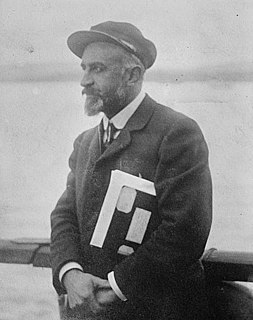| Geography | |
|---|---|
| Location | Antarctica |
| Coordinates | 66°12′S66°44′W / 66.200°S 66.733°W Coordinates: 66°12′S66°44′W / 66.200°S 66.733°W |
| Archipelago | Biscoe Islands |
| Length | 29 km (18 mi) |
| Width | 8 km (5 mi) |
| Administration | |
| Administered under the Antarctic Treaty System | |
Lavoisier Island is an island 29 km (18 mi) long and 8 km (5 mi) wide, lying between Rabot and Watkins Islands in the Biscoe Islands, Antarctica. It is separated from Renaud Island and Rabot Island to the northeast by Pendleton Strait, from Watkins Island to the southwest by Lewis Sound, and from Krogh Island to the west-southwest by Vladigerov Passage.

Rabot Island is an island 8 km (5 mi) long and 3 km (2 mi) wide, lying 1.6 km (1 mi) south of Renaud Island in the Biscoe Islands. First charted by the French Antarctic Expedition, 1903–05, under Jean-Baptiste Charcot, who named it for Charles Rabot.

Watkins Island is a low lying, ice-covered island 5 miles (8 km) long, lying 3 miles (5 km) SW of Lavoisier Island in the Biscoe Islands. The island was first mapped by the French Antarctic Expedition under Jean-Baptiste Charcot, 1903–05 and 1908–10, but remained unnamed until resighted by the BGLE under Rymill, 1934–37. He gave the name Mikkelsen Island after Ejnar Mikkelsen, Danish Arctic explorer. In applying the name, Rymill was unaware of the existence of Mikkelsen Islands 75 mi (121 km) southwestward, named in 1908–10 by Charcot. To avoid confusion of the two, the UK-APC recommended in 1952 that the Rymill naming be amended. The new name, Watkins Island, commemorates Gino Watkins, leader of the British Arctic Air Route Expedition, 1930–31. A new feature, Mikkelsen Bay, has been named for Ejnar Mikkelsen.

Biscoe Islands is a series of islands, of which the principal ones are Renaud, Lavoisier, Watkins, Krogh, Pickwick and Rabot, lying parallel to the west coast of Graham Land and extending 150 km (81 nmi) between Southwind Passage on the northeast and Matha Strait on the southwest. Another group of islands are the Adolph Islands.
Contents
Lavoisier Island is named Isla Serrano by Chile and isla Mitre by Argentina.

Chile, officially the Republic of Chile, is a South American country occupying a long, narrow strip of land between the Andes to the east and the Pacific Ocean to the west. It borders Peru to the north, Bolivia to the northeast, Argentina to the east, and the Drake Passage in the far south. Chilean territory includes the Pacific islands of Juan Fernández, Salas y Gómez, Desventuradas, and Easter Island in Oceania. Chile also claims about 1,250,000 square kilometres (480,000 sq mi) of Antarctica, although all claims are suspended under the Antarctic Treaty.

Argentina, officially the Argentine Republic, is a country located mostly in the southern half of South America. Sharing the bulk of the Southern Cone with Chile to the west, the country is also bordered by Bolivia and Paraguay to the north, Brazil to the northeast, Uruguay and the South Atlantic Ocean to the east, and the Drake Passage to the south. With a mainland area of 2,780,400 km2 (1,073,500 sq mi), Argentina is the eighth-largest country in the world, the fourth largest in the Americas, and the largest Spanish-speaking nation. The sovereign state is subdivided into twenty-three provinces and one autonomous city, Buenos Aires, which is the federal capital of the nation as decided by Congress. The provinces and the capital have their own constitutions, but exist under a federal system. Argentina claims sovereignty over part of Antarctica, the Falkland Islands, and South Georgia and the South Sandwich Islands.
The island was first charted by the French Antarctic Expedition, 1903–05, under Jean-Baptiste Charcot, and named "Ile Nansen" after Fridtjof Nansen, Norwegian Arctic explorer. To avoid confusion with Nansen Island (q.v.) in Wilhelmina Bay, the UK-APC recommended in 1960 that the island be renamed for Antoine Laurent Lavoisier, French chemist who pioneered the study of metabolism.
The French Antarctic Expedition is any of several French expeditions in Antarctica.

Jean-Baptiste-Étienne-Auguste Charcot, born in Neuilly-sur-Seine, was a French scientist, medical doctor and polar scientist. His father was the neurologist Jean-Martin Charcot (1825–1893).

Fridtjof Wedel-Jarlsberg Nansen was a Norwegian explorer, scientist, diplomat, humanitarian and Nobel Peace Prize laureate. In his youth he was a champion skier and ice skater. He led the team that made the first crossing of the Greenland interior in 1888, traversing the island on cross-country skis. He won international fame after reaching a record northern latitude of 86°14′ during his Fram expedition of 1893–1896. Although he retired from exploration after his return to Norway, his techniques of polar travel and his innovations in equipment and clothing influenced a generation of subsequent Arctic and Antarctic expeditions.



